Business Law: Analyzing Contract Law and Consumer Law Remedies
VerifiedAdded on 2024/06/03
|13
|2732
|376
Case Study
AI Summary
This assignment presents a comprehensive analysis of two distinct legal issues within the realm of business law. The first issue revolves around a contract dispute where Angela alleges fraud by Jessica in the sale of a business, focusing on the remedies available to Angela upon discovering misrepresentation. The analysis applies relevant contract law principles, including the impact of misrepresentation on contract enforceability, referencing key cases such as Futuretronics International Pty Ltd v Gadzhis and Google Inc v ACCC to illustrate the legal implications. Remedies like rescission and compensation are explored, guided by the Misrepresentation Act 1972 and cases like Alati v Kruger. The second issue examines the potential liability of Acme Cola Company Ltd. to Sandra Smith after her husband consumed a cola containing a decomposed cockroach. This section delves into Australian Consumer Law, particularly the Consumer Act 1987 and Product Safety Regulations 2005, to assess the manufacturer's responsibility for product safety and the consumer's rights to compensation for damages caused by defective products, referencing cases like Donoghue v Stevenson and MacPherson v Buick Motor. The assignment concludes that Sandra is entitled to compensation due to Acme Cola Company Ltd.'s negligence in ensuring product safety.
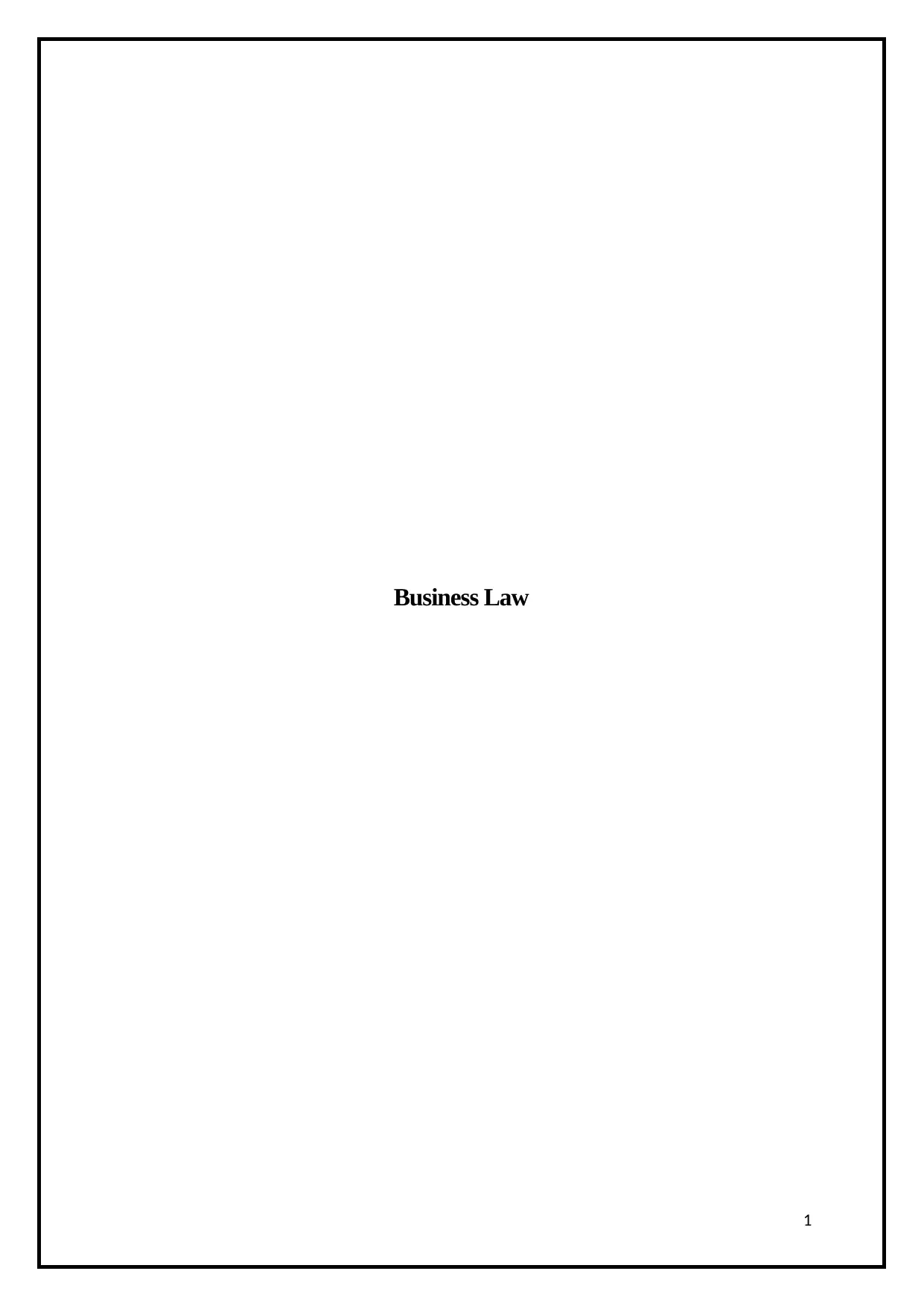
Business Law
1
1
Paraphrase This Document
Need a fresh take? Get an instant paraphrase of this document with our AI Paraphraser
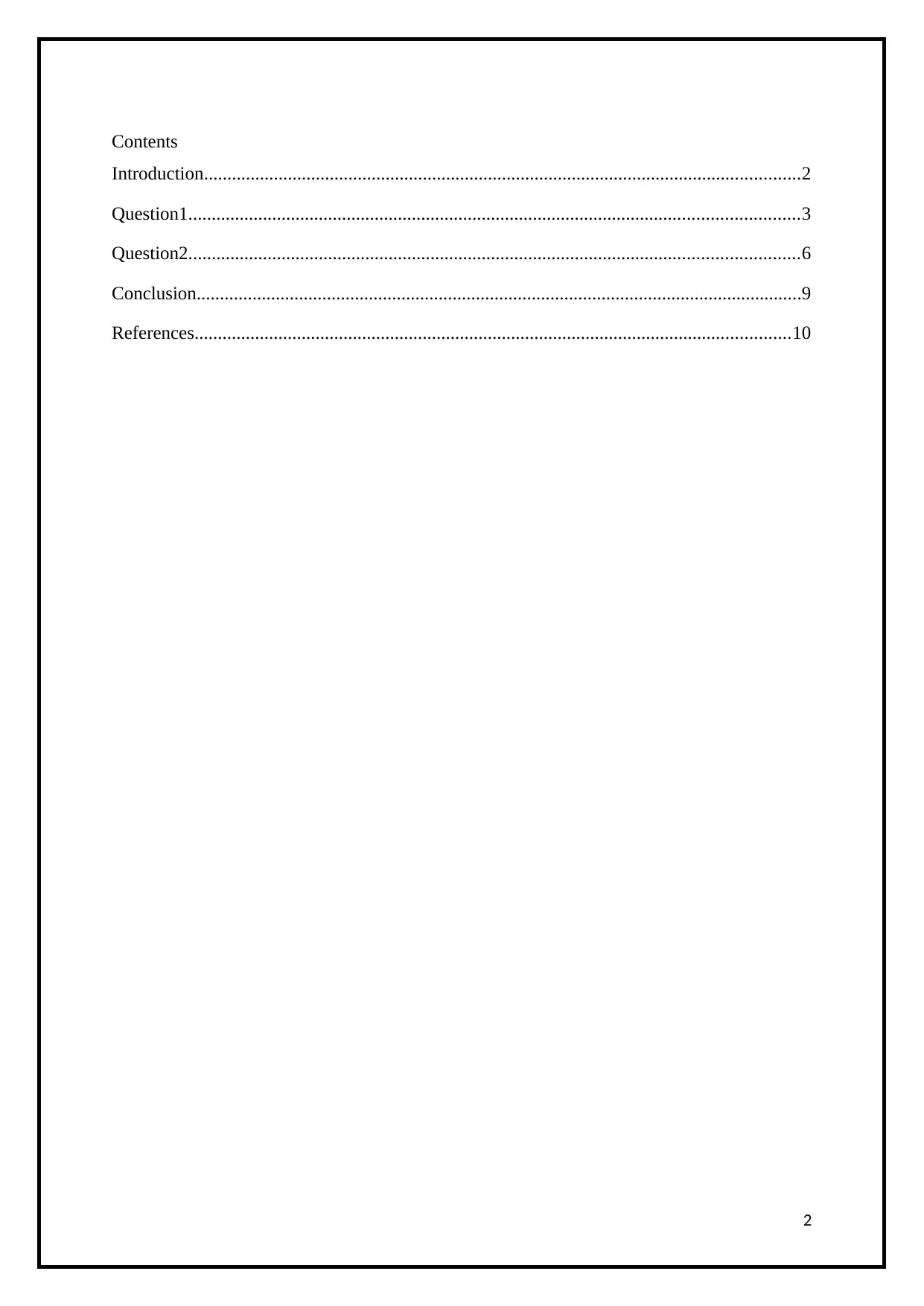
Contents
Introduction................................................................................................................................2
Question1...................................................................................................................................3
Question2...................................................................................................................................6
Conclusion..................................................................................................................................9
References................................................................................................................................10
2
Introduction................................................................................................................................2
Question1...................................................................................................................................3
Question2...................................................................................................................................6
Conclusion..................................................................................................................................9
References................................................................................................................................10
2
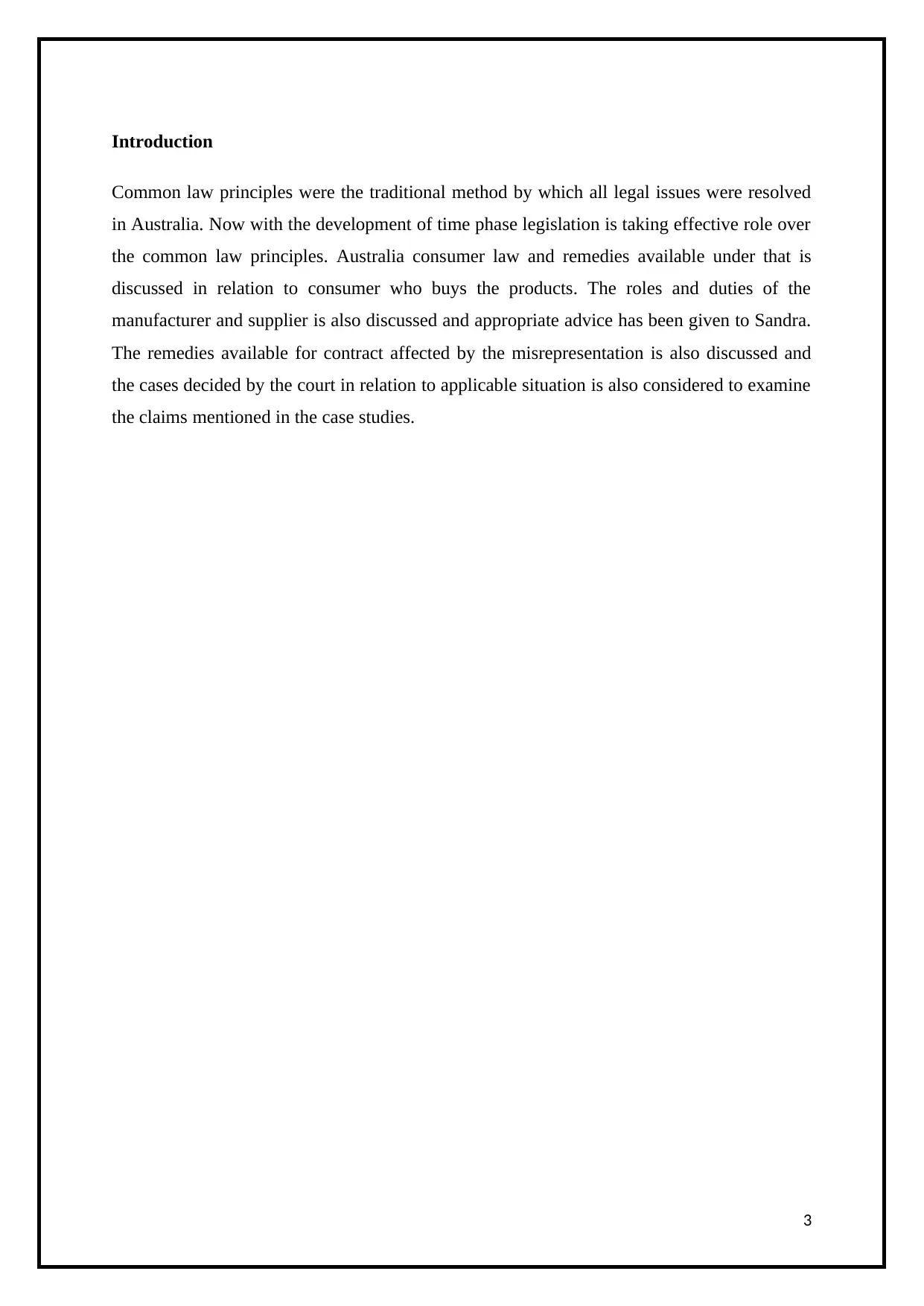
Introduction
Common law principles were the traditional method by which all legal issues were resolved
in Australia. Now with the development of time phase legislation is taking effective role over
the common law principles. Australia consumer law and remedies available under that is
discussed in relation to consumer who buys the products. The roles and duties of the
manufacturer and supplier is also discussed and appropriate advice has been given to Sandra.
The remedies available for contract affected by the misrepresentation is also discussed and
the cases decided by the court in relation to applicable situation is also considered to examine
the claims mentioned in the case studies.
3
Common law principles were the traditional method by which all legal issues were resolved
in Australia. Now with the development of time phase legislation is taking effective role over
the common law principles. Australia consumer law and remedies available under that is
discussed in relation to consumer who buys the products. The roles and duties of the
manufacturer and supplier is also discussed and appropriate advice has been given to Sandra.
The remedies available for contract affected by the misrepresentation is also discussed and
the cases decided by the court in relation to applicable situation is also considered to examine
the claims mentioned in the case studies.
3
⊘ This is a preview!⊘
Do you want full access?
Subscribe today to unlock all pages.

Trusted by 1+ million students worldwide
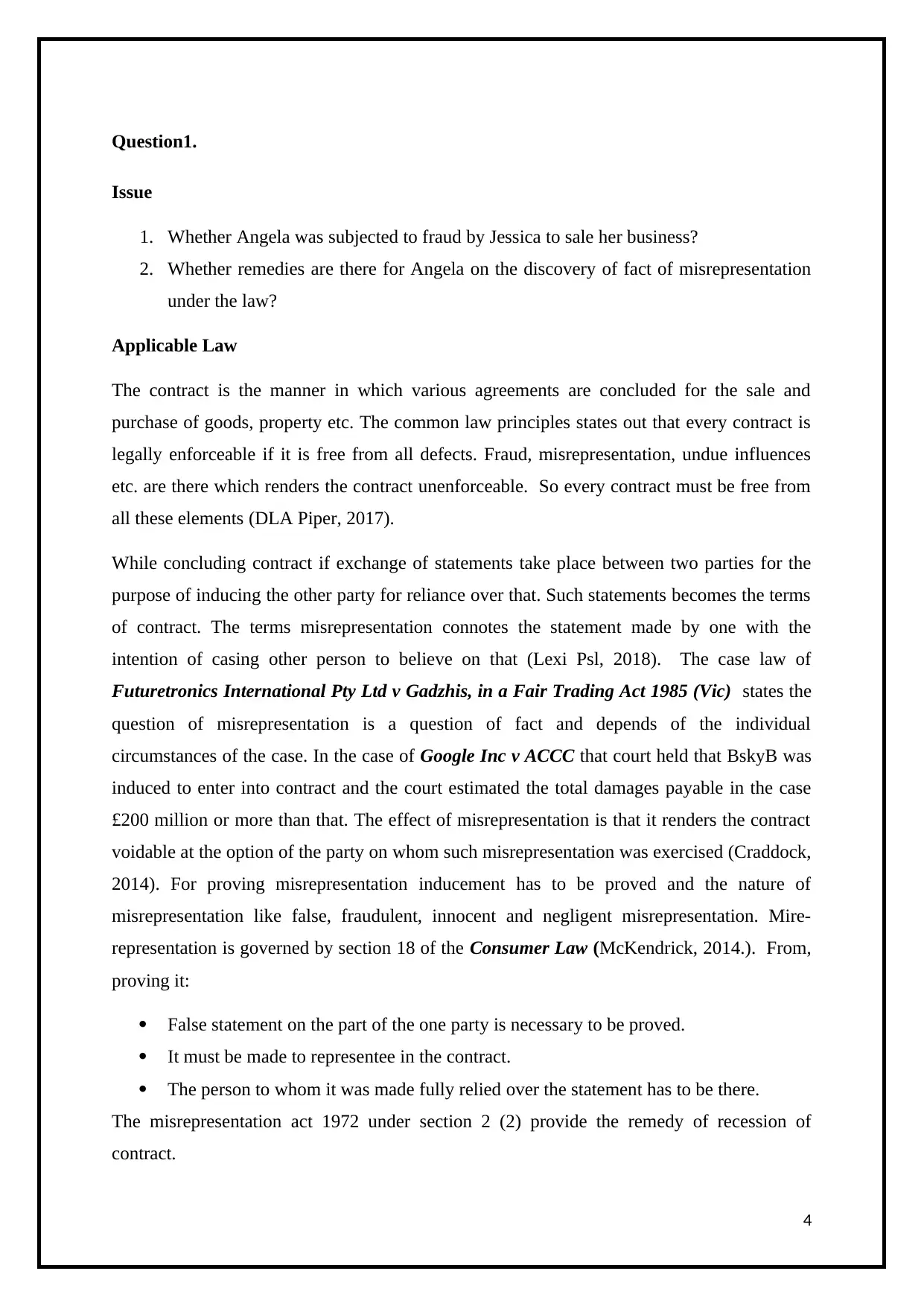
Question1.
Issue
1. Whether Angela was subjected to fraud by Jessica to sale her business?
2. Whether remedies are there for Angela on the discovery of fact of misrepresentation
under the law?
Applicable Law
The contract is the manner in which various agreements are concluded for the sale and
purchase of goods, property etc. The common law principles states out that every contract is
legally enforceable if it is free from all defects. Fraud, misrepresentation, undue influences
etc. are there which renders the contract unenforceable. So every contract must be free from
all these elements (DLA Piper, 2017).
While concluding contract if exchange of statements take place between two parties for the
purpose of inducing the other party for reliance over that. Such statements becomes the terms
of contract. The terms misrepresentation connotes the statement made by one with the
intention of casing other person to believe on that (Lexi Psl, 2018). The case law of
Futuretronics International Pty Ltd v Gadzhis, in a Fair Trading Act 1985 (Vic) states the
question of misrepresentation is a question of fact and depends of the individual
circumstances of the case. In the case of Google Inc v ACCC that court held that BskyB was
induced to enter into contract and the court estimated the total damages payable in the case
£200 million or more than that. The effect of misrepresentation is that it renders the contract
voidable at the option of the party on whom such misrepresentation was exercised (Craddock,
2014). For proving misrepresentation inducement has to be proved and the nature of
misrepresentation like false, fraudulent, innocent and negligent misrepresentation. Mire-
representation is governed by section 18 of the Consumer Law (McKendrick, 2014.). From,
proving it:
False statement on the part of the one party is necessary to be proved.
It must be made to representee in the contract.
The person to whom it was made fully relied over the statement has to be there.
The misrepresentation act 1972 under section 2 (2) provide the remedy of recession of
contract.
4
Issue
1. Whether Angela was subjected to fraud by Jessica to sale her business?
2. Whether remedies are there for Angela on the discovery of fact of misrepresentation
under the law?
Applicable Law
The contract is the manner in which various agreements are concluded for the sale and
purchase of goods, property etc. The common law principles states out that every contract is
legally enforceable if it is free from all defects. Fraud, misrepresentation, undue influences
etc. are there which renders the contract unenforceable. So every contract must be free from
all these elements (DLA Piper, 2017).
While concluding contract if exchange of statements take place between two parties for the
purpose of inducing the other party for reliance over that. Such statements becomes the terms
of contract. The terms misrepresentation connotes the statement made by one with the
intention of casing other person to believe on that (Lexi Psl, 2018). The case law of
Futuretronics International Pty Ltd v Gadzhis, in a Fair Trading Act 1985 (Vic) states the
question of misrepresentation is a question of fact and depends of the individual
circumstances of the case. In the case of Google Inc v ACCC that court held that BskyB was
induced to enter into contract and the court estimated the total damages payable in the case
£200 million or more than that. The effect of misrepresentation is that it renders the contract
voidable at the option of the party on whom such misrepresentation was exercised (Craddock,
2014). For proving misrepresentation inducement has to be proved and the nature of
misrepresentation like false, fraudulent, innocent and negligent misrepresentation. Mire-
representation is governed by section 18 of the Consumer Law (McKendrick, 2014.). From,
proving it:
False statement on the part of the one party is necessary to be proved.
It must be made to representee in the contract.
The person to whom it was made fully relied over the statement has to be there.
The misrepresentation act 1972 under section 2 (2) provide the remedy of recession of
contract.
4
Paraphrase This Document
Need a fresh take? Get an instant paraphrase of this document with our AI Paraphraser
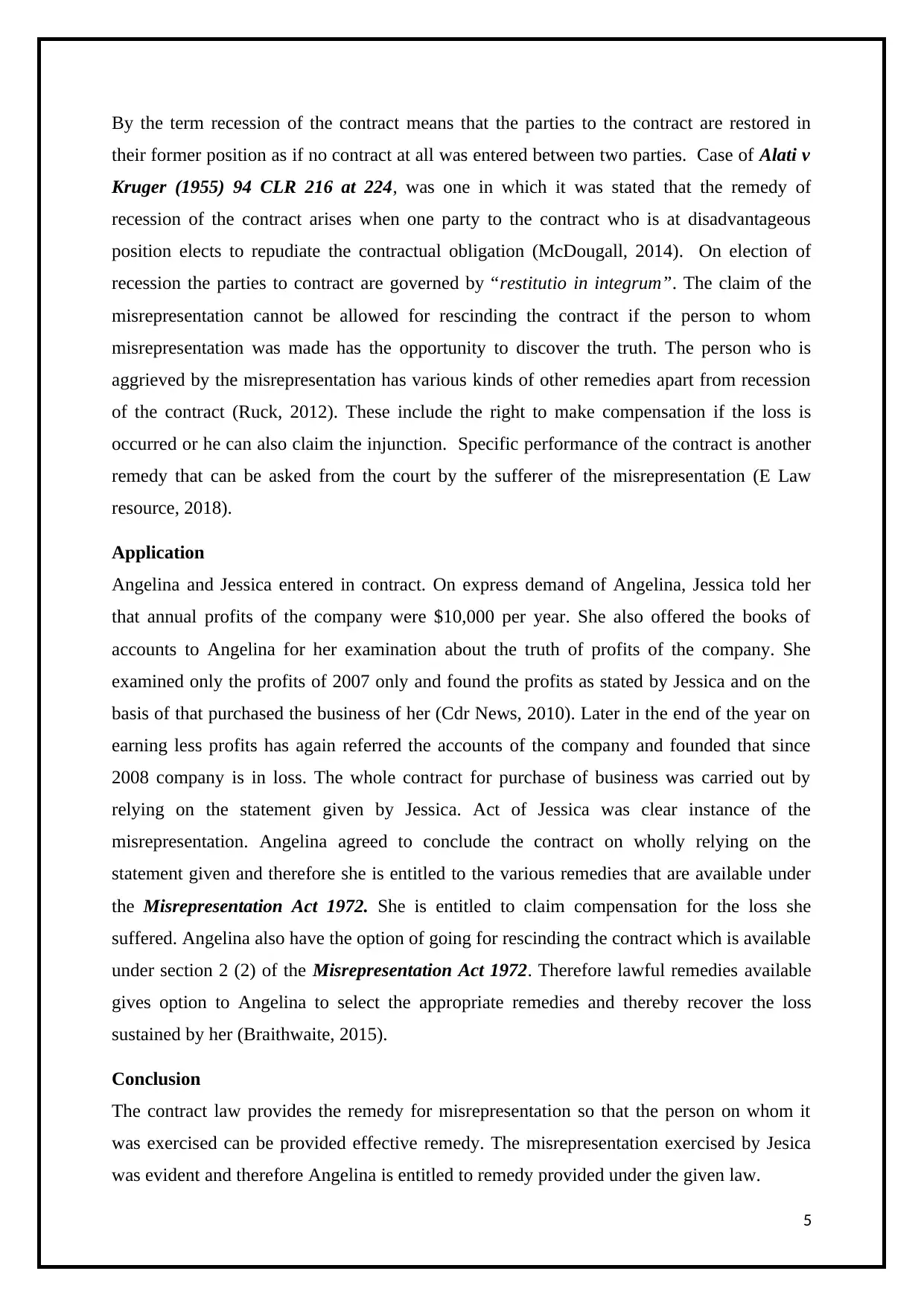
By the term recession of the contract means that the parties to the contract are restored in
their former position as if no contract at all was entered between two parties. Case of Alati v
Kruger (1955) 94 CLR 216 at 224, was one in which it was stated that the remedy of
recession of the contract arises when one party to the contract who is at disadvantageous
position elects to repudiate the contractual obligation (McDougall, 2014). On election of
recession the parties to contract are governed by “restitutio in integrum”. The claim of the
misrepresentation cannot be allowed for rescinding the contract if the person to whom
misrepresentation was made has the opportunity to discover the truth. The person who is
aggrieved by the misrepresentation has various kinds of other remedies apart from recession
of the contract (Ruck, 2012). These include the right to make compensation if the loss is
occurred or he can also claim the injunction. Specific performance of the contract is another
remedy that can be asked from the court by the sufferer of the misrepresentation (E Law
resource, 2018).
Application
Angelina and Jessica entered in contract. On express demand of Angelina, Jessica told her
that annual profits of the company were $10,000 per year. She also offered the books of
accounts to Angelina for her examination about the truth of profits of the company. She
examined only the profits of 2007 only and found the profits as stated by Jessica and on the
basis of that purchased the business of her (Cdr News, 2010). Later in the end of the year on
earning less profits has again referred the accounts of the company and founded that since
2008 company is in loss. The whole contract for purchase of business was carried out by
relying on the statement given by Jessica. Act of Jessica was clear instance of the
misrepresentation. Angelina agreed to conclude the contract on wholly relying on the
statement given and therefore she is entitled to the various remedies that are available under
the Misrepresentation Act 1972. She is entitled to claim compensation for the loss she
suffered. Angelina also have the option of going for rescinding the contract which is available
under section 2 (2) of the Misrepresentation Act 1972. Therefore lawful remedies available
gives option to Angelina to select the appropriate remedies and thereby recover the loss
sustained by her (Braithwaite, 2015).
Conclusion
The contract law provides the remedy for misrepresentation so that the person on whom it
was exercised can be provided effective remedy. The misrepresentation exercised by Jesica
was evident and therefore Angelina is entitled to remedy provided under the given law.
5
their former position as if no contract at all was entered between two parties. Case of Alati v
Kruger (1955) 94 CLR 216 at 224, was one in which it was stated that the remedy of
recession of the contract arises when one party to the contract who is at disadvantageous
position elects to repudiate the contractual obligation (McDougall, 2014). On election of
recession the parties to contract are governed by “restitutio in integrum”. The claim of the
misrepresentation cannot be allowed for rescinding the contract if the person to whom
misrepresentation was made has the opportunity to discover the truth. The person who is
aggrieved by the misrepresentation has various kinds of other remedies apart from recession
of the contract (Ruck, 2012). These include the right to make compensation if the loss is
occurred or he can also claim the injunction. Specific performance of the contract is another
remedy that can be asked from the court by the sufferer of the misrepresentation (E Law
resource, 2018).
Application
Angelina and Jessica entered in contract. On express demand of Angelina, Jessica told her
that annual profits of the company were $10,000 per year. She also offered the books of
accounts to Angelina for her examination about the truth of profits of the company. She
examined only the profits of 2007 only and found the profits as stated by Jessica and on the
basis of that purchased the business of her (Cdr News, 2010). Later in the end of the year on
earning less profits has again referred the accounts of the company and founded that since
2008 company is in loss. The whole contract for purchase of business was carried out by
relying on the statement given by Jessica. Act of Jessica was clear instance of the
misrepresentation. Angelina agreed to conclude the contract on wholly relying on the
statement given and therefore she is entitled to the various remedies that are available under
the Misrepresentation Act 1972. She is entitled to claim compensation for the loss she
suffered. Angelina also have the option of going for rescinding the contract which is available
under section 2 (2) of the Misrepresentation Act 1972. Therefore lawful remedies available
gives option to Angelina to select the appropriate remedies and thereby recover the loss
sustained by her (Braithwaite, 2015).
Conclusion
The contract law provides the remedy for misrepresentation so that the person on whom it
was exercised can be provided effective remedy. The misrepresentation exercised by Jesica
was evident and therefore Angelina is entitled to remedy provided under the given law.
5
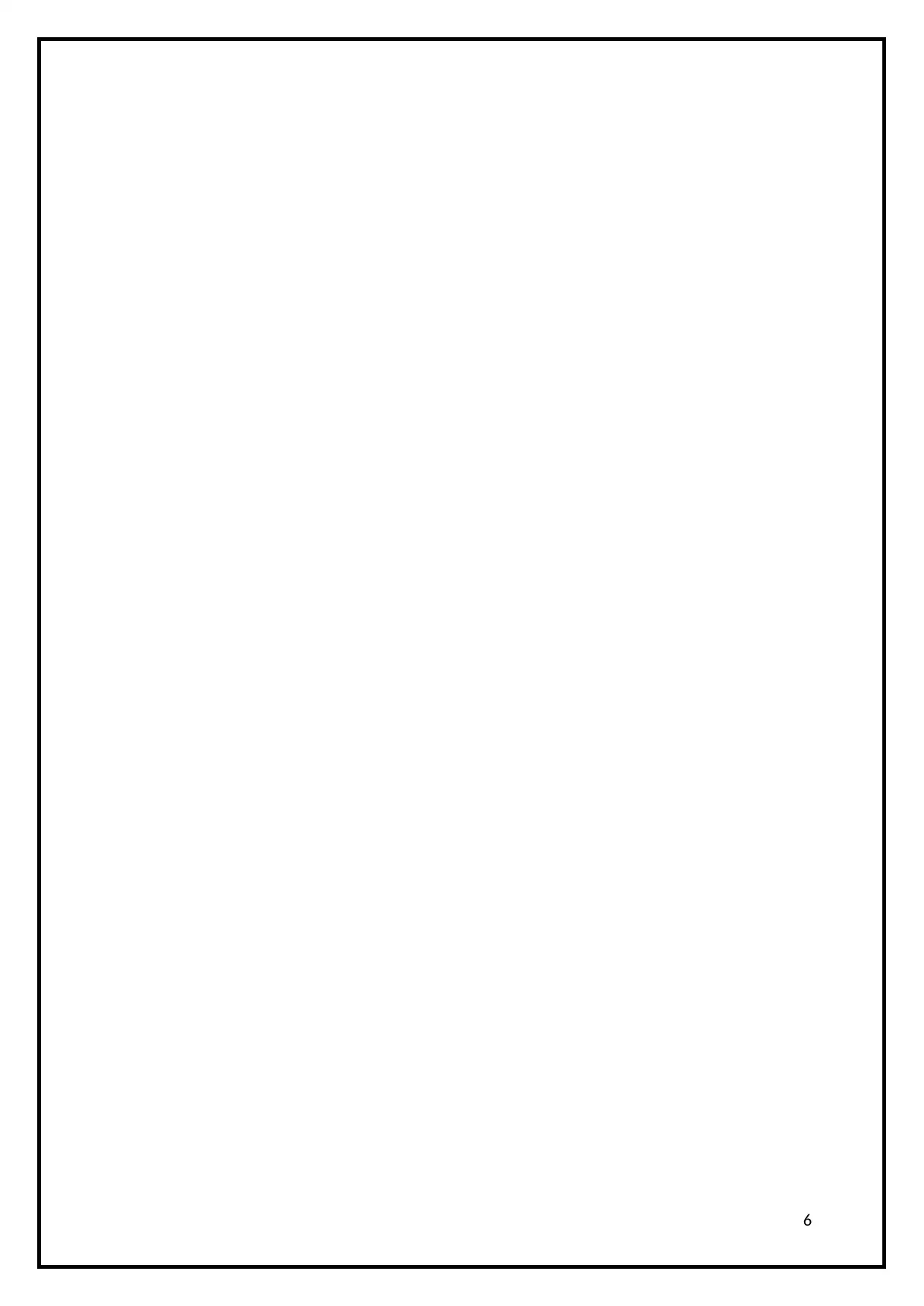
6
⊘ This is a preview!⊘
Do you want full access?
Subscribe today to unlock all pages.

Trusted by 1+ million students worldwide
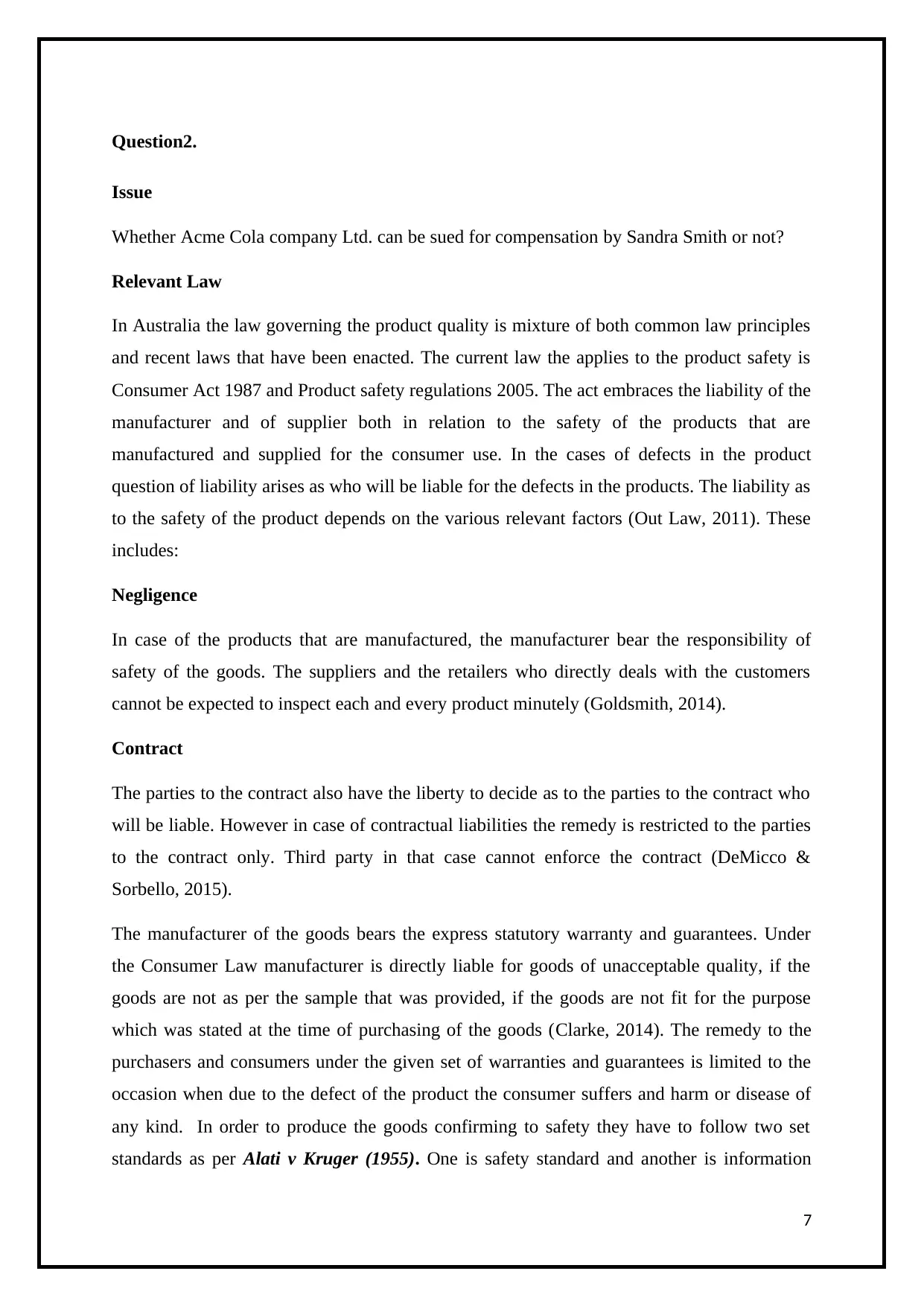
Question2.
Issue
Whether Acme Cola company Ltd. can be sued for compensation by Sandra Smith or not?
Relevant Law
In Australia the law governing the product quality is mixture of both common law principles
and recent laws that have been enacted. The current law the applies to the product safety is
Consumer Act 1987 and Product safety regulations 2005. The act embraces the liability of the
manufacturer and of supplier both in relation to the safety of the products that are
manufactured and supplied for the consumer use. In the cases of defects in the product
question of liability arises as who will be liable for the defects in the products. The liability as
to the safety of the product depends on the various relevant factors (Out Law, 2011). These
includes:
Negligence
In case of the products that are manufactured, the manufacturer bear the responsibility of
safety of the goods. The suppliers and the retailers who directly deals with the customers
cannot be expected to inspect each and every product minutely (Goldsmith, 2014).
Contract
The parties to the contract also have the liberty to decide as to the parties to the contract who
will be liable. However in case of contractual liabilities the remedy is restricted to the parties
to the contract only. Third party in that case cannot enforce the contract (DeMicco &
Sorbello, 2015).
The manufacturer of the goods bears the express statutory warranty and guarantees. Under
the Consumer Law manufacturer is directly liable for goods of unacceptable quality, if the
goods are not as per the sample that was provided, if the goods are not fit for the purpose
which was stated at the time of purchasing of the goods (Clarke, 2014). The remedy to the
purchasers and consumers under the given set of warranties and guarantees is limited to the
occasion when due to the defect of the product the consumer suffers and harm or disease of
any kind. In order to produce the goods confirming to safety they have to follow two set
standards as per Alati v Kruger (1955). One is safety standard and another is information
7
Issue
Whether Acme Cola company Ltd. can be sued for compensation by Sandra Smith or not?
Relevant Law
In Australia the law governing the product quality is mixture of both common law principles
and recent laws that have been enacted. The current law the applies to the product safety is
Consumer Act 1987 and Product safety regulations 2005. The act embraces the liability of the
manufacturer and of supplier both in relation to the safety of the products that are
manufactured and supplied for the consumer use. In the cases of defects in the product
question of liability arises as who will be liable for the defects in the products. The liability as
to the safety of the product depends on the various relevant factors (Out Law, 2011). These
includes:
Negligence
In case of the products that are manufactured, the manufacturer bear the responsibility of
safety of the goods. The suppliers and the retailers who directly deals with the customers
cannot be expected to inspect each and every product minutely (Goldsmith, 2014).
Contract
The parties to the contract also have the liberty to decide as to the parties to the contract who
will be liable. However in case of contractual liabilities the remedy is restricted to the parties
to the contract only. Third party in that case cannot enforce the contract (DeMicco &
Sorbello, 2015).
The manufacturer of the goods bears the express statutory warranty and guarantees. Under
the Consumer Law manufacturer is directly liable for goods of unacceptable quality, if the
goods are not as per the sample that was provided, if the goods are not fit for the purpose
which was stated at the time of purchasing of the goods (Clarke, 2014). The remedy to the
purchasers and consumers under the given set of warranties and guarantees is limited to the
occasion when due to the defect of the product the consumer suffers and harm or disease of
any kind. In order to produce the goods confirming to safety they have to follow two set
standards as per Alati v Kruger (1955). One is safety standard and another is information
7
Paraphrase This Document
Need a fresh take? Get an instant paraphrase of this document with our AI Paraphraser
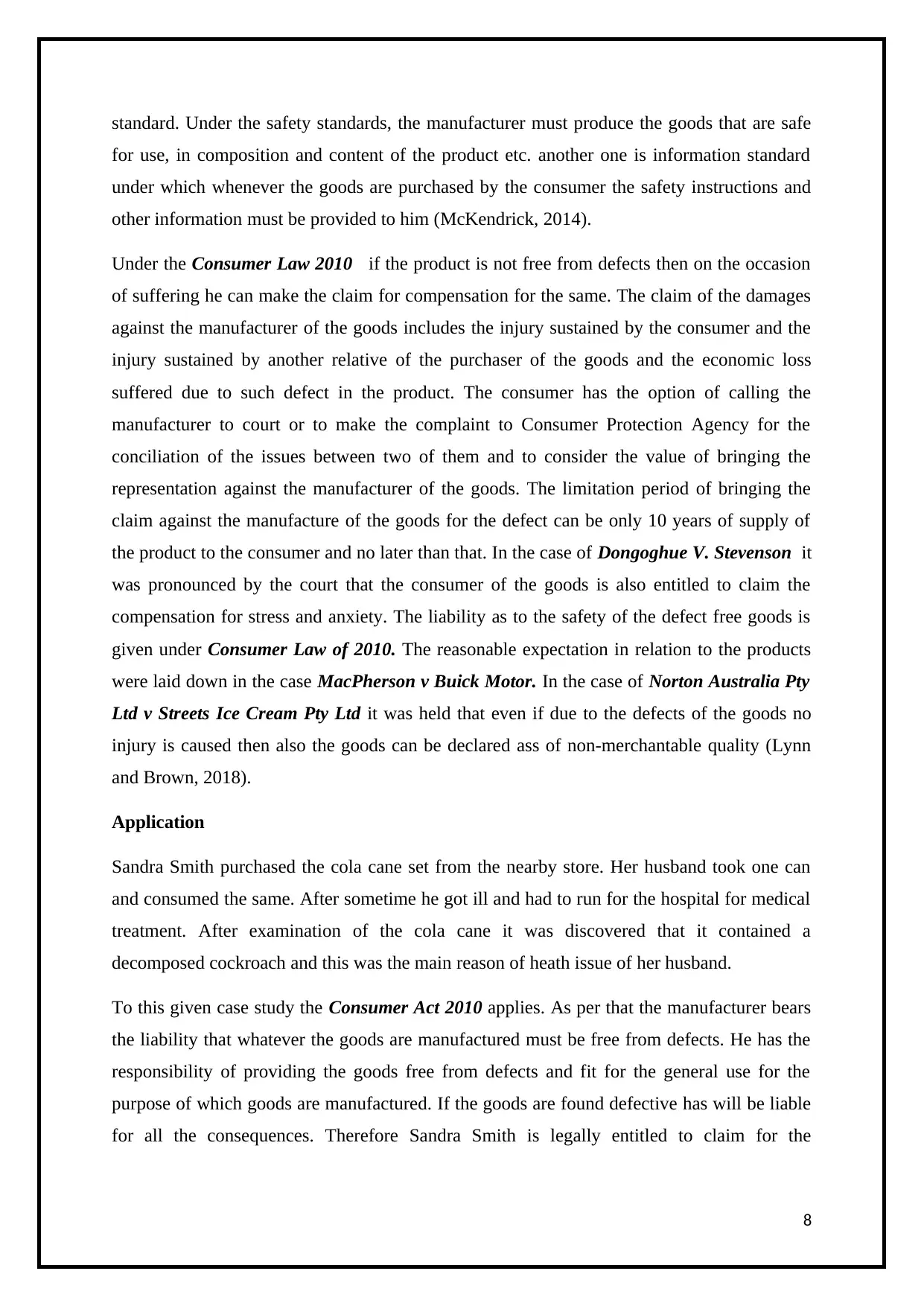
standard. Under the safety standards, the manufacturer must produce the goods that are safe
for use, in composition and content of the product etc. another one is information standard
under which whenever the goods are purchased by the consumer the safety instructions and
other information must be provided to him (McKendrick, 2014).
Under the Consumer Law 2010 if the product is not free from defects then on the occasion
of suffering he can make the claim for compensation for the same. The claim of the damages
against the manufacturer of the goods includes the injury sustained by the consumer and the
injury sustained by another relative of the purchaser of the goods and the economic loss
suffered due to such defect in the product. The consumer has the option of calling the
manufacturer to court or to make the complaint to Consumer Protection Agency for the
conciliation of the issues between two of them and to consider the value of bringing the
representation against the manufacturer of the goods. The limitation period of bringing the
claim against the manufacture of the goods for the defect can be only 10 years of supply of
the product to the consumer and no later than that. In the case of Dongoghue V. Stevenson it
was pronounced by the court that the consumer of the goods is also entitled to claim the
compensation for stress and anxiety. The liability as to the safety of the defect free goods is
given under Consumer Law of 2010. The reasonable expectation in relation to the products
were laid down in the case MacPherson v Buick Motor. In the case of Norton Australia Pty
Ltd v Streets Ice Cream Pty Ltd it was held that even if due to the defects of the goods no
injury is caused then also the goods can be declared ass of non-merchantable quality (Lynn
and Brown, 2018).
Application
Sandra Smith purchased the cola cane set from the nearby store. Her husband took one can
and consumed the same. After sometime he got ill and had to run for the hospital for medical
treatment. After examination of the cola cane it was discovered that it contained a
decomposed cockroach and this was the main reason of heath issue of her husband.
To this given case study the Consumer Act 2010 applies. As per that the manufacturer bears
the liability that whatever the goods are manufactured must be free from defects. He has the
responsibility of providing the goods free from defects and fit for the general use for the
purpose of which goods are manufactured. If the goods are found defective has will be liable
for all the consequences. Therefore Sandra Smith is legally entitled to claim for the
8
for use, in composition and content of the product etc. another one is information standard
under which whenever the goods are purchased by the consumer the safety instructions and
other information must be provided to him (McKendrick, 2014).
Under the Consumer Law 2010 if the product is not free from defects then on the occasion
of suffering he can make the claim for compensation for the same. The claim of the damages
against the manufacturer of the goods includes the injury sustained by the consumer and the
injury sustained by another relative of the purchaser of the goods and the economic loss
suffered due to such defect in the product. The consumer has the option of calling the
manufacturer to court or to make the complaint to Consumer Protection Agency for the
conciliation of the issues between two of them and to consider the value of bringing the
representation against the manufacturer of the goods. The limitation period of bringing the
claim against the manufacture of the goods for the defect can be only 10 years of supply of
the product to the consumer and no later than that. In the case of Dongoghue V. Stevenson it
was pronounced by the court that the consumer of the goods is also entitled to claim the
compensation for stress and anxiety. The liability as to the safety of the defect free goods is
given under Consumer Law of 2010. The reasonable expectation in relation to the products
were laid down in the case MacPherson v Buick Motor. In the case of Norton Australia Pty
Ltd v Streets Ice Cream Pty Ltd it was held that even if due to the defects of the goods no
injury is caused then also the goods can be declared ass of non-merchantable quality (Lynn
and Brown, 2018).
Application
Sandra Smith purchased the cola cane set from the nearby store. Her husband took one can
and consumed the same. After sometime he got ill and had to run for the hospital for medical
treatment. After examination of the cola cane it was discovered that it contained a
decomposed cockroach and this was the main reason of heath issue of her husband.
To this given case study the Consumer Act 2010 applies. As per that the manufacturer bears
the liability that whatever the goods are manufactured must be free from defects. He has the
responsibility of providing the goods free from defects and fit for the general use for the
purpose of which goods are manufactured. If the goods are found defective has will be liable
for all the consequences. Therefore Sandra Smith is legally entitled to claim for the
8
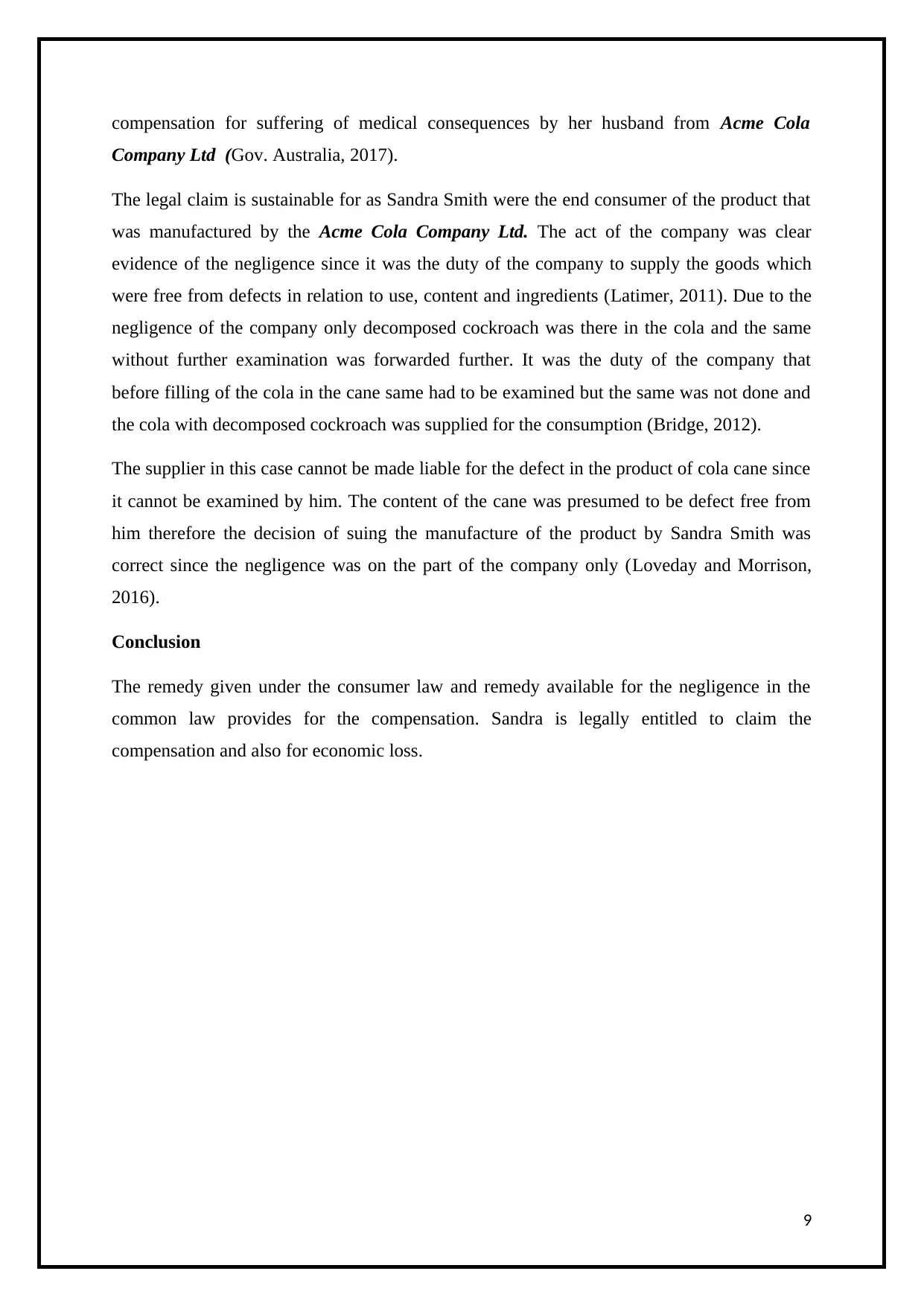
compensation for suffering of medical consequences by her husband from Acme Cola
Company Ltd (Gov. Australia, 2017).
The legal claim is sustainable for as Sandra Smith were the end consumer of the product that
was manufactured by the Acme Cola Company Ltd. The act of the company was clear
evidence of the negligence since it was the duty of the company to supply the goods which
were free from defects in relation to use, content and ingredients (Latimer, 2011). Due to the
negligence of the company only decomposed cockroach was there in the cola and the same
without further examination was forwarded further. It was the duty of the company that
before filling of the cola in the cane same had to be examined but the same was not done and
the cola with decomposed cockroach was supplied for the consumption (Bridge, 2012).
The supplier in this case cannot be made liable for the defect in the product of cola cane since
it cannot be examined by him. The content of the cane was presumed to be defect free from
him therefore the decision of suing the manufacture of the product by Sandra Smith was
correct since the negligence was on the part of the company only (Loveday and Morrison,
2016).
Conclusion
The remedy given under the consumer law and remedy available for the negligence in the
common law provides for the compensation. Sandra is legally entitled to claim the
compensation and also for economic loss.
9
Company Ltd (Gov. Australia, 2017).
The legal claim is sustainable for as Sandra Smith were the end consumer of the product that
was manufactured by the Acme Cola Company Ltd. The act of the company was clear
evidence of the negligence since it was the duty of the company to supply the goods which
were free from defects in relation to use, content and ingredients (Latimer, 2011). Due to the
negligence of the company only decomposed cockroach was there in the cola and the same
without further examination was forwarded further. It was the duty of the company that
before filling of the cola in the cane same had to be examined but the same was not done and
the cola with decomposed cockroach was supplied for the consumption (Bridge, 2012).
The supplier in this case cannot be made liable for the defect in the product of cola cane since
it cannot be examined by him. The content of the cane was presumed to be defect free from
him therefore the decision of suing the manufacture of the product by Sandra Smith was
correct since the negligence was on the part of the company only (Loveday and Morrison,
2016).
Conclusion
The remedy given under the consumer law and remedy available for the negligence in the
common law provides for the compensation. Sandra is legally entitled to claim the
compensation and also for economic loss.
9
⊘ This is a preview!⊘
Do you want full access?
Subscribe today to unlock all pages.

Trusted by 1+ million students worldwide
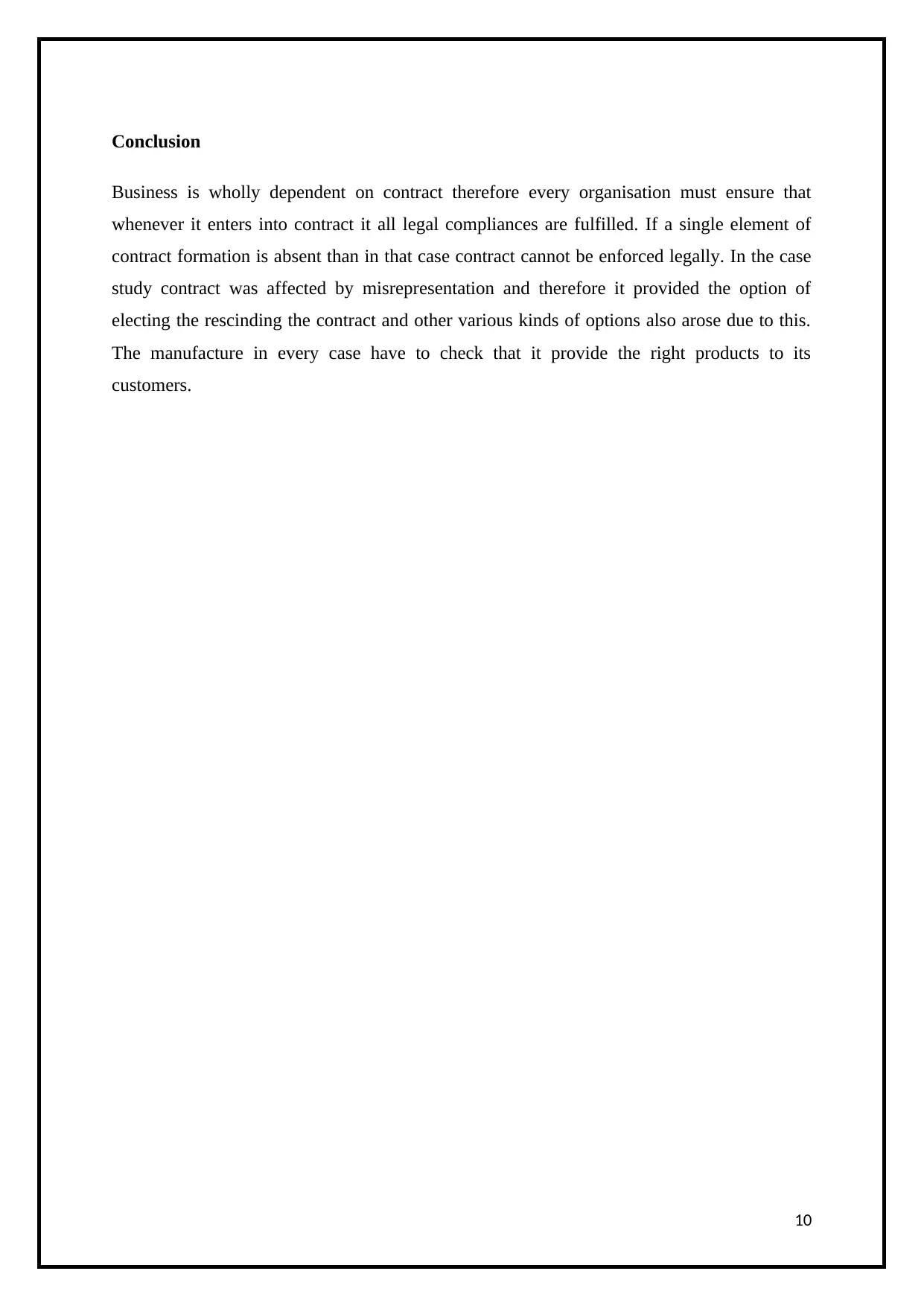
Conclusion
Business is wholly dependent on contract therefore every organisation must ensure that
whenever it enters into contract it all legal compliances are fulfilled. If a single element of
contract formation is absent than in that case contract cannot be enforced legally. In the case
study contract was affected by misrepresentation and therefore it provided the option of
electing the rescinding the contract and other various kinds of options also arose due to this.
The manufacture in every case have to check that it provide the right products to its
customers.
10
Business is wholly dependent on contract therefore every organisation must ensure that
whenever it enters into contract it all legal compliances are fulfilled. If a single element of
contract formation is absent than in that case contract cannot be enforced legally. In the case
study contract was affected by misrepresentation and therefore it provided the option of
electing the rescinding the contract and other various kinds of options also arose due to this.
The manufacture in every case have to check that it provide the right products to its
customers.
10
Paraphrase This Document
Need a fresh take? Get an instant paraphrase of this document with our AI Paraphraser
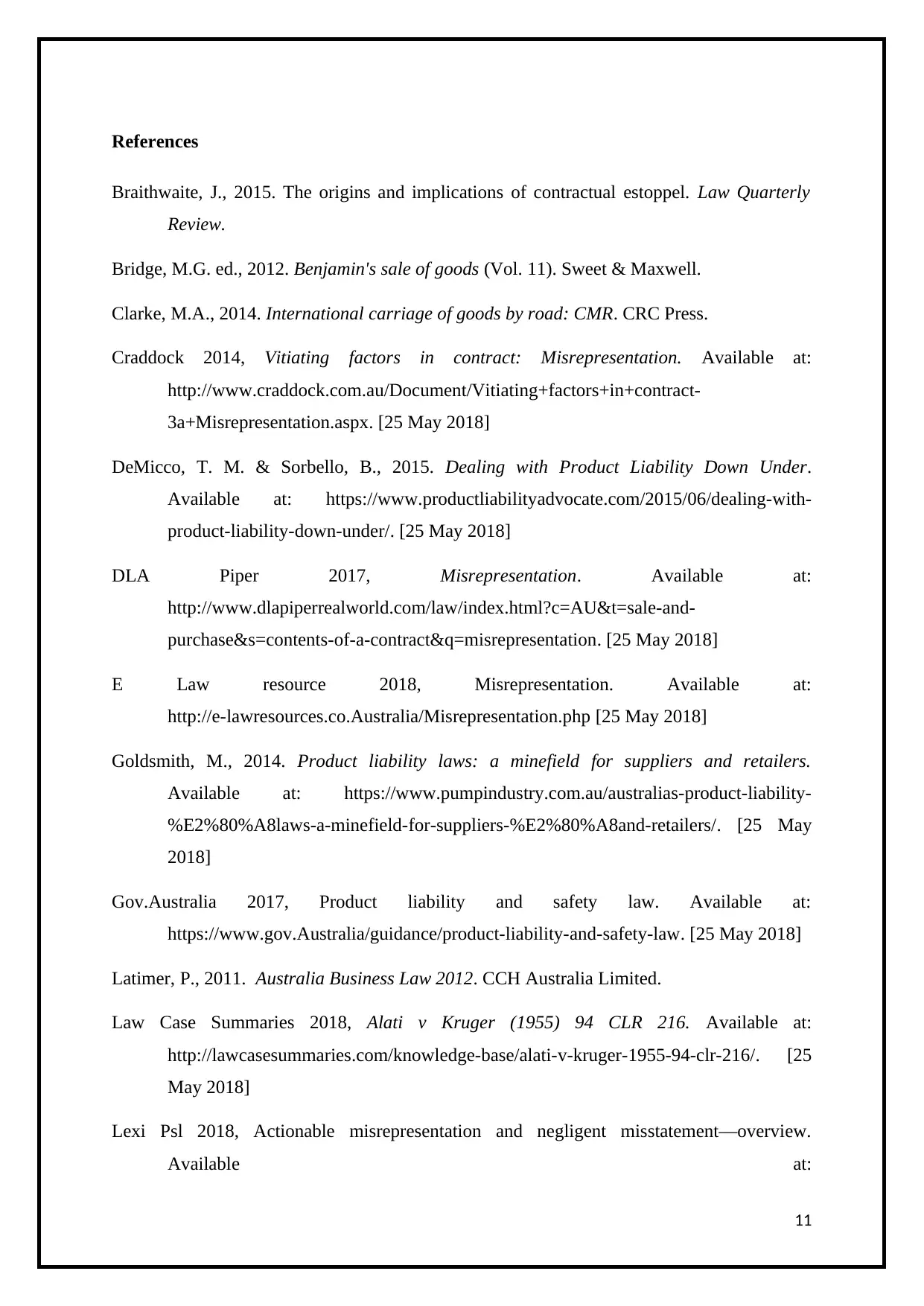
References
Braithwaite, J., 2015. The origins and implications of contractual estoppel. Law Quarterly
Review.
Bridge, M.G. ed., 2012. Benjamin's sale of goods (Vol. 11). Sweet & Maxwell.
Clarke, M.A., 2014. International carriage of goods by road: CMR. CRC Press.
Craddock 2014, Vitiating factors in contract: Misrepresentation. Available at:
http://www.craddock.com.au/Document/Vitiating+factors+in+contract-
3a+Misrepresentation.aspx. [25 May 2018]
DeMicco, T. M. & Sorbello, B., 2015. Dealing with Product Liability Down Under.
Available at: https://www.productliabilityadvocate.com/2015/06/dealing-with-
product-liability-down-under/. [25 May 2018]
DLA Piper 2017, Misrepresentation. Available at:
http://www.dlapiperrealworld.com/law/index.html?c=AU&t=sale-and-
purchase&s=contents-of-a-contract&q=misrepresentation. [25 May 2018]
E Law resource 2018, Misrepresentation. Available at:
http://e-lawresources.co.Australia/Misrepresentation.php [25 May 2018]
Goldsmith, M., 2014. Product liability laws: a minefield for suppliers and retailers.
Available at: https://www.pumpindustry.com.au/australias-product-liability-
%E2%80%A8laws-a-minefield-for-suppliers-%E2%80%A8and-retailers/. [25 May
2018]
Gov.Australia 2017, Product liability and safety law. Available at:
https://www.gov.Australia/guidance/product-liability-and-safety-law. [25 May 2018]
Latimer, P., 2011. Australia Business Law 2012. CCH Australia Limited.
Law Case Summaries 2018, Alati v Kruger (1955) 94 CLR 216. Available at:
http://lawcasesummaries.com/knowledge-base/alati-v-kruger-1955-94-clr-216/. [25
May 2018]
Lexi Psl 2018, Actionable misrepresentation and negligent misstatement—overview.
Available at:
11
Braithwaite, J., 2015. The origins and implications of contractual estoppel. Law Quarterly
Review.
Bridge, M.G. ed., 2012. Benjamin's sale of goods (Vol. 11). Sweet & Maxwell.
Clarke, M.A., 2014. International carriage of goods by road: CMR. CRC Press.
Craddock 2014, Vitiating factors in contract: Misrepresentation. Available at:
http://www.craddock.com.au/Document/Vitiating+factors+in+contract-
3a+Misrepresentation.aspx. [25 May 2018]
DeMicco, T. M. & Sorbello, B., 2015. Dealing with Product Liability Down Under.
Available at: https://www.productliabilityadvocate.com/2015/06/dealing-with-
product-liability-down-under/. [25 May 2018]
DLA Piper 2017, Misrepresentation. Available at:
http://www.dlapiperrealworld.com/law/index.html?c=AU&t=sale-and-
purchase&s=contents-of-a-contract&q=misrepresentation. [25 May 2018]
E Law resource 2018, Misrepresentation. Available at:
http://e-lawresources.co.Australia/Misrepresentation.php [25 May 2018]
Goldsmith, M., 2014. Product liability laws: a minefield for suppliers and retailers.
Available at: https://www.pumpindustry.com.au/australias-product-liability-
%E2%80%A8laws-a-minefield-for-suppliers-%E2%80%A8and-retailers/. [25 May
2018]
Gov.Australia 2017, Product liability and safety law. Available at:
https://www.gov.Australia/guidance/product-liability-and-safety-law. [25 May 2018]
Latimer, P., 2011. Australia Business Law 2012. CCH Australia Limited.
Law Case Summaries 2018, Alati v Kruger (1955) 94 CLR 216. Available at:
http://lawcasesummaries.com/knowledge-base/alati-v-kruger-1955-94-clr-216/. [25
May 2018]
Lexi Psl 2018, Actionable misrepresentation and negligent misstatement—overview.
Available at:
11
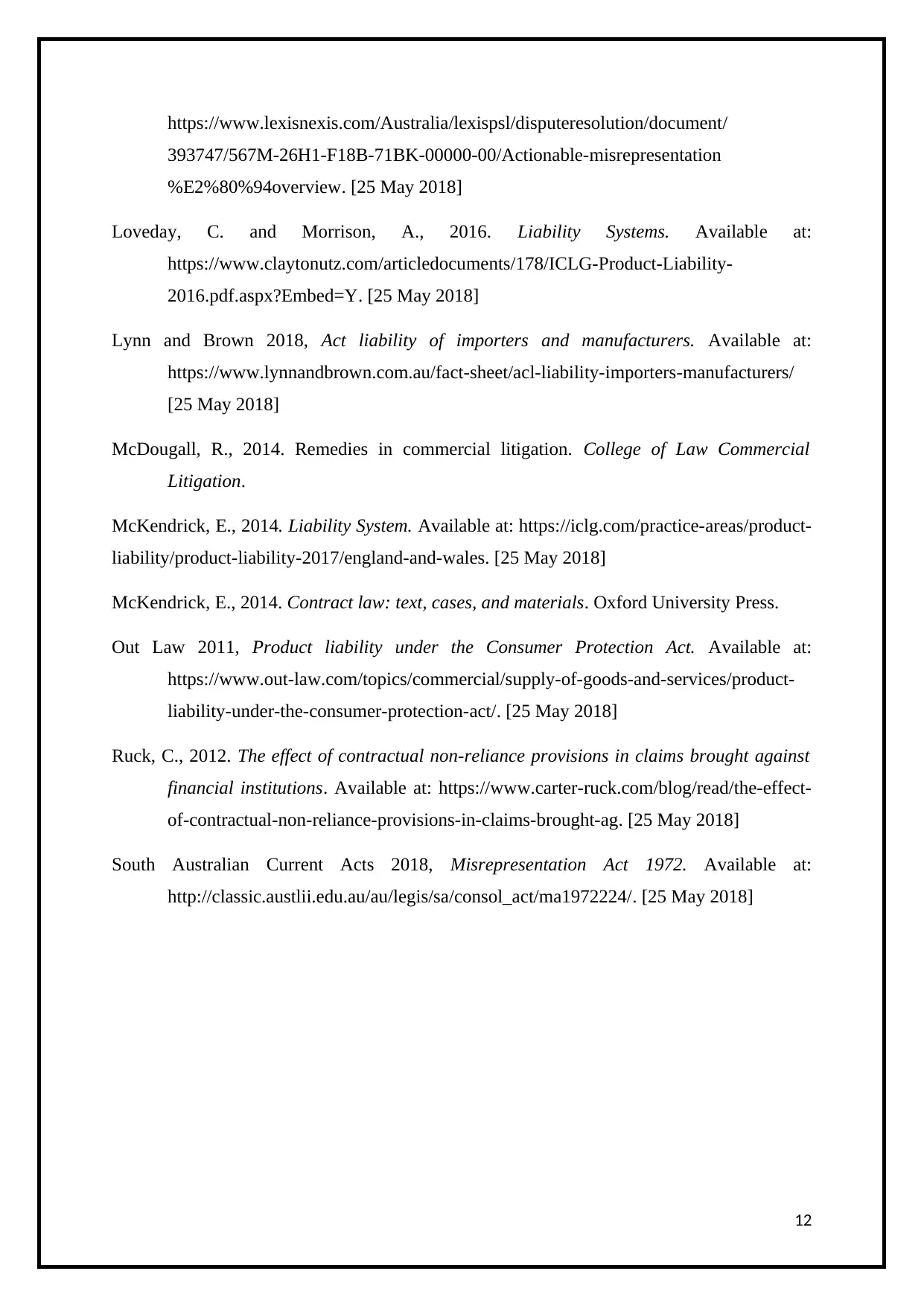
https://www.lexisnexis.com/Australia/lexispsl/disputeresolution/document/
393747/567M-26H1-F18B-71BK-00000-00/Actionable-misrepresentation
%E2%80%94overview. [25 May 2018]
Loveday, C. and Morrison, A., 2016. Liability Systems. Available at:
https://www.claytonutz.com/articledocuments/178/ICLG-Product-Liability-
2016.pdf.aspx?Embed=Y. [25 May 2018]
Lynn and Brown 2018, Act liability of importers and manufacturers. Available at:
https://www.lynnandbrown.com.au/fact-sheet/acl-liability-importers-manufacturers/
[25 May 2018]
McDougall, R., 2014. Remedies in commercial litigation. College of Law Commercial
Litigation.
McKendrick, E., 2014. Liability System. Available at: https://iclg.com/practice-areas/product-
liability/product-liability-2017/england-and-wales. [25 May 2018]
McKendrick, E., 2014. Contract law: text, cases, and materials. Oxford University Press.
Out Law 2011, Product liability under the Consumer Protection Act. Available at:
https://www.out-law.com/topics/commercial/supply-of-goods-and-services/product-
liability-under-the-consumer-protection-act/. [25 May 2018]
Ruck, C., 2012. The effect of contractual non-reliance provisions in claims brought against
financial institutions. Available at: https://www.carter-ruck.com/blog/read/the-effect-
of-contractual-non-reliance-provisions-in-claims-brought-ag. [25 May 2018]
South Australian Current Acts 2018, Misrepresentation Act 1972. Available at:
http://classic.austlii.edu.au/au/legis/sa/consol_act/ma1972224/. [25 May 2018]
12
393747/567M-26H1-F18B-71BK-00000-00/Actionable-misrepresentation
%E2%80%94overview. [25 May 2018]
Loveday, C. and Morrison, A., 2016. Liability Systems. Available at:
https://www.claytonutz.com/articledocuments/178/ICLG-Product-Liability-
2016.pdf.aspx?Embed=Y. [25 May 2018]
Lynn and Brown 2018, Act liability of importers and manufacturers. Available at:
https://www.lynnandbrown.com.au/fact-sheet/acl-liability-importers-manufacturers/
[25 May 2018]
McDougall, R., 2014. Remedies in commercial litigation. College of Law Commercial
Litigation.
McKendrick, E., 2014. Liability System. Available at: https://iclg.com/practice-areas/product-
liability/product-liability-2017/england-and-wales. [25 May 2018]
McKendrick, E., 2014. Contract law: text, cases, and materials. Oxford University Press.
Out Law 2011, Product liability under the Consumer Protection Act. Available at:
https://www.out-law.com/topics/commercial/supply-of-goods-and-services/product-
liability-under-the-consumer-protection-act/. [25 May 2018]
Ruck, C., 2012. The effect of contractual non-reliance provisions in claims brought against
financial institutions. Available at: https://www.carter-ruck.com/blog/read/the-effect-
of-contractual-non-reliance-provisions-in-claims-brought-ag. [25 May 2018]
South Australian Current Acts 2018, Misrepresentation Act 1972. Available at:
http://classic.austlii.edu.au/au/legis/sa/consol_act/ma1972224/. [25 May 2018]
12
⊘ This is a preview!⊘
Do you want full access?
Subscribe today to unlock all pages.

Trusted by 1+ million students worldwide
1 out of 13
Related Documents
Your All-in-One AI-Powered Toolkit for Academic Success.
+13062052269
info@desklib.com
Available 24*7 on WhatsApp / Email
![[object Object]](/_next/static/media/star-bottom.7253800d.svg)
Unlock your academic potential
Copyright © 2020–2025 A2Z Services. All Rights Reserved. Developed and managed by ZUCOL.





